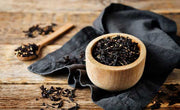What Makes Black Tea, Black?

Understanding the Process of Black Tea
Black tea, a beloved beverage enjoyed by tea drinkers worldwide, is steeped in rich history and tradition.
Its unique flavor profile and deep color are the result of a meticulous process that transforms fresh tea leaves into the robust drink we know and love.
In this article, we will delve into the fascinating journey of black tea. From the initial withering of the leaves to the final drying stage.
We'll also answer the question, "What makes black tea black?" and introduce you to the various types of black tea.
So, let's embark on this journey together, one cup at a time.
The Journey from Leaf to Cup
The journey of black tea begins with the harvesting of fresh leaves from the Camellia sinensis plant. The timing of the harvest can influence the tea's flavor profile.
Once harvested, the leaves undergo a series of steps. These include withering, rolling, oxidation, and drying. Each step is crucial in shaping the tea's final characteristics.
The process is a delicate balance of art and science steeped in tradition. It requires careful attention to detail and a deep understanding of the tea plant. Each cup of black tea is a testament to the skill and craftsmanship of the tea maker.

Where Does Black Tea Come From?
Black tea is cultivated in various regions around the world. The 10 largest producers of black tea are:
- China
- India
- Kenya
- Sri Lanka
- Vietnam
- Turkey
- Iran
- Indonesia
- Argentina
- Japan
Chinese black tea tops the list producing 3.9 million tons in 2023.
The unique flavor and characteristics of black tea are influenced by regional factors like climate, soil, and processing methods.
Withering: The First Step in Black Tea Processing
Withering is the first step in the black tea process. It involves spreading the harvested leaves in a thin layer to allow them to wilt. This step reduces the moisture content in the leaves. It also makes them pliable, preparing them for the next stage of the process.
Withering can take several hours and can vary depending on factors like the temperature and humidity.
Rolling: Shaping the Flavor of Black Tea
After withering, the leaves are rolled to shape the leaves and begin the oxidation process.
Rolling breaks down the cell walls of the leaves. This releases the leaf juices and enzymes that contribute to the tea's flavor and aroma.
There are two main methods of rolling:
Whole leaf tea often uses the Orthodox method which gently rolls and twists the leaves, preserving their shape.
Tea bags typically undergo the CTC (Crush, Tear, Curl) method which crushes, tears, and curls the leaves into small, uniform pieces.
Oxidation: What Makes Black Tea Black
Oxidation, also known as fermentation, is what makes black tea leaves black. The enzymes in the tea leaves react with oxygen changing the color of the leaves from green to a dark brown or black.
Black tea is fully oxidized. This gives it a darker color and richer flavor compared to other teas like green or white tea. It is also what develops the tea's flavor and aroma. The longer the oxidation, the stronger and richer the tea.
Drying: Locking in the Richness
The final step in the black tea process is drying. This step stops the oxidation process and stabilizes the tea leaves.
Drying also locks in the flavor and aroma developed during oxidation. It reduces the moisture content of the leaves to a level suitable for storage.

Exploring the Black Tea Varieties
Black tea comes in a variety of flavors and aromas. Black tea types are influenced by factors such as the origin of the tea plant and the processing methods.
Different regions produce distinct black tea varieties with unique characteristics and flavor profiles.
Some of the most popular black tea varieties are:
- Assam, from the Assam region of India, is known for its bold, malty flavor, and is often used in breakfast blends.
- Darjeeling, from the Darjeeling region in India, is lighter variety and known for its muscatel flavor.
- Ceylon tea from Sri Lanka has a crisp, citrusy character.
- Keemun black tea from China, known for its wine-like, fruity taste
- Kenyan black tea is often used in blends for its strong color and flavor.
The Grading of Black Tea Leaves
The grading of black tea leaves is based on their size and quality. Loose leaf black tea is considered the highest grade. The whole leaves result in the complex flavors that loose leaf teas are famous for.
Broken leaves, fannings, and dust are lower grades used in tea bags. These grades infuse quickly and produce a strong, robust flavor.
Is Chai Black Tea?
Chai is often made with black tea as its base. Chai, particularly Masala Chai, is a spiced tea that combines black tea with various spices and often milk.
Black tea gives chai its strong flavor and dark color. This makes chai a favorite in many cultures, especially in India.
However, you can also find Chai with White tea, Green tea, or Rooibos as a base tea. This expands your choices for caffeine when selecting chai tea.
The Health Benefits of Black Tea
Black tea is not just a flavorful beverage. It also offers a range of health benefits.
A significant advantage of black tea is its abundant antioxidant properties. By neutralizing harmful free radicals in the body, the risk of chronic diseases may be reduced.
The caffeine in black coffee can improve alertness and focus, making it a great choice for those needing a mental boost.
If you are calorie conscious, no need to worry about black tea calories. If you don't drink your black tea with milk and sugar, the caloric count comes in at a negligible 2 calories.
While black tea has health benefits, it should be consumed as part of a balanced diet. Always consult with a healthcare professional before using black tea for medicinal purposes.

Brewing the Perfect Cup of Black Tea
Brewing the perfect cup of black tea is an art. It starts with using high-quality tea leaves. The water temperature and brewing time also play a crucial role.
The ideal water temperature for black tea is just below boiling, around 200°F (93°C). Steep the tea for 3-5 minutes in the hot water, depending on your taste preference.
The strong rich flavor of black tea holds up well when chilled and diluted with ice. The the taste remains vibrant and enjoyable making black iced tea a popular drink. A great way to stay hydrated while reaping the antioxidant benefits.
Black Tea vs Green Tea
The difference between green and black tea primarily lies in their processing methods and flavor profiles.
Black tea is fully oxidized, which gives it a darker color and a stronger, richer flavor. It undergoes a process that includes withering, rolling, oxidation, and drying. This oxidation process is what makes black tea black and contributes to its robust taste.
On the other hand, green tea is minimally processed and is not oxidized. The leaves are quickly steamed or pan-fried after they are picked. This stops oxidation and keeps their green color and fresh, grassy taste. As a result, green tea tends to have a lighter taste and a more delicate aroma compared to black tea.
Does Black or Green tea have more caffeine?
When comparing the amount of caffeine, black tea generally contains more caffeine than green tea. Both varieties of tea provide health advantages, however, their antioxidant characteristics vary due to the different processing techniques.
Caffeine Content of Black Tea vs Coffee
Black loose leaf tea usually has 40 to 70 mg of caffeine in an 8-ounce cup. In comparison, coffee has much more caffeine. An 8-ounce cup of coffee averages about 95 to 200 mg.
When thinking about caffeine content, it's important to note that brewing methods and steeping times can change the caffeine levels in both drinks.
Conclusion: Explore the World of Black Tea
Understanding the black tea process can enhance your appreciation of this beloved beverage. Take some time to explore the types of black tea, enjoy its flavor, and learn about its culture and history.





